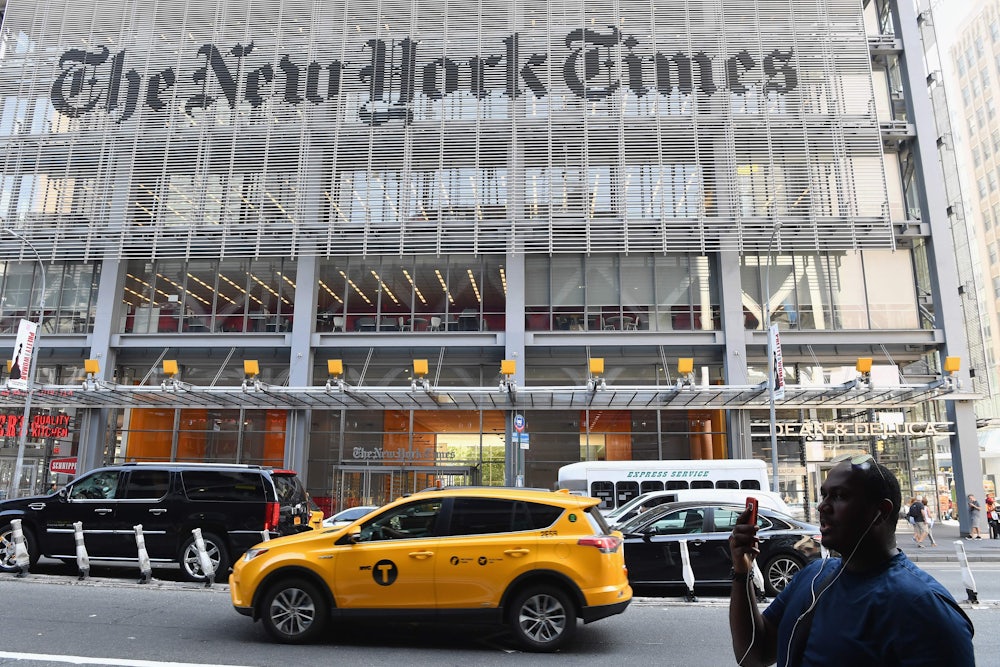On Sunday, after much fanfare, The New York Times’ editorial board announced its presidential endorsement, which was actually a decision to endorse two candidates: Elizabeth Warren and Amy Klobuchar. “Both the radical and the realist models” being offered in the Democratic primary “warrant serious consideration,” the board wrote, and so voters must decide which is “best suited for repairing the Republic.”
As much as the op-ed served to announce the board’s endorsements, it was also an opportunity to issue some warnings: “Any hope of restoring unity in the country will require modesty, a willingness to compromise and the support of the many demographics that make up the Democratic coalition—young and old, in red states and blue, black and brown and white.” Bernie Sanders, they argued, would merely exchange “one over-promising, divisive figure in Washington for another.” (This is also where Warren falters, according to the board: “She sometimes sounds like a candidate who sees a universe of us-versus-thems, who, in the general election, would be going up against a president who has already divided America into his own version of them and us.”)
The rhetoric of unity to restore American democracy feels good on its face, but the board seems untroubled by and uninterested in the question of who, exactly, might be united under a future president. And by what?
Unity, as a virtue unto itself, is inadequate to the task of justice. After all, as the Times implies, Donald Trump has united the far right and much of his own party around his nativist vision for America. To the editorial board, even with a demagogue in office and income inequality now the worst in America’s recorded history, it appears that “unity” candidates are those who use acceptable, institutional means to make adjustments around the margins of the status quo. But for those who engage in or study movement work, there are bigger fish to fry than Robert’s Rules of Order. So without an adamant demand for economic, racial, and other kinds of justice—what actual good does unity do?
Unity implies some sort of harmony, and the Times board makes it clear that the rhetoric of peace takes precedence over material concerns: It reserves its harshest tone not for Michael Bloomberg—whose policing policies inflicted violence upon thousands of innocent Black and Latinx New Yorkers—but for Sanders, whom they equate to Trump. (Bloomberg’s alleged conduct toward women who worked for him resembles Trump’s crude sexism, but this parallel goes unremarked upon by the Times.)
And as much as the editorial board calls for unity, its definition of the term is not entirely coherent. Klobuchar, it appears, appeals to the board’s desire for unity because of the amount of legislation she has passed with bipartisan support. Warren, likewise, “talks more about bringing together Democrats, Republicans, and independents behind her proposals.”
If those are the terms then, sure, Klobuchar and Warren are fine candidates. However, the op-ed fails to consider other ideas of unity. What does unity mean for victims of the criminal justice system when their choice is someone like Klobuchar, who pursued harsher penalties for nonviolent offenders? What does unity mean for the Indigenous community, who challenged Warren’s claims of Native American ancestry until she apologized in the midst of her campaign last year? What does unity mean for working-class voters who find their concerns best articulated through a dissenting voice challenging America’s pervasive wealth inequality?
While Sanders may not have the bipartisan legislative record or rhetoric of unity that seems to appeal most to the editorial board, he has built a multiracial coalition of working-class voters. While Klobuchar and Warren may boast unity across congressional aisles, Sanders outperforms other Democrats among independent voters in a head-to-head against Trump and in independent donor contributions. (None of this is to say that Sanders is free from critique, with notable misfires on race since he became a formidable challenge to Hillary Clinton in the 2016 primaries.)
Still, it calls into question what the Times means by “divisive.” The policies Sanders has mainstreamed through his candidacy are broadly popular—Medicare for All, in particular. If Sanders’s “divisiveness” is just shorthand for dissent against a violent status quo, how is that a problem?
It’s hard, then, not to step back and take a more cynical view of the board’s rationale: The rhetoric of democracy and unity is more about appearances than actual equality and justice for millions of people. In its coverage of issues from the Haymarket bombing to the Red Scare, media companies have traditionally vilified left organizing, and in the week when we celebrate Martin Luther King Jr., it cannot go without saying that American media also ostracized him for his anti-racist, anti-imperialist, and anti-capitalist stances.
In the Times’ framing, unity—and the kind of peace and prosperity that for so long has been denied to people of color, poor people, immigrants, LGBTQ people, and others—is for the privileged few, liberals and conservatives alike. But millions of people outside the scope of this “unity” cannot afford to let rhetoric take precedence over their lived, intergenerational experiences of oppression and inequality. The Times may find a perfect marriage in endorsing candidates who meet its values of process and unity, whatever “unity” actually means. The kind of robustly left, disruptive campaign Sanders is building engenders its own kind of unity—just not, according to the Times, among the right kinds of people.
